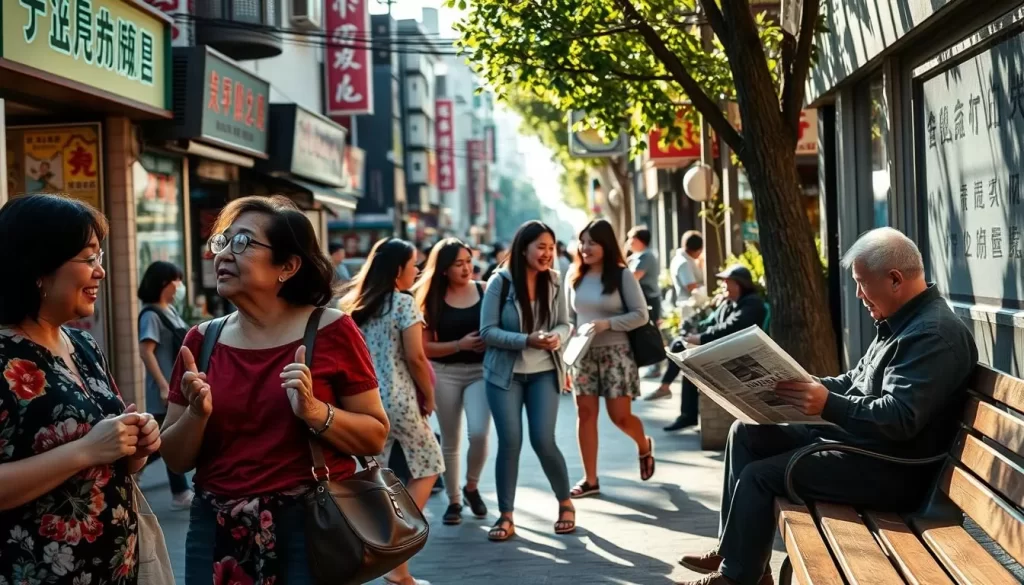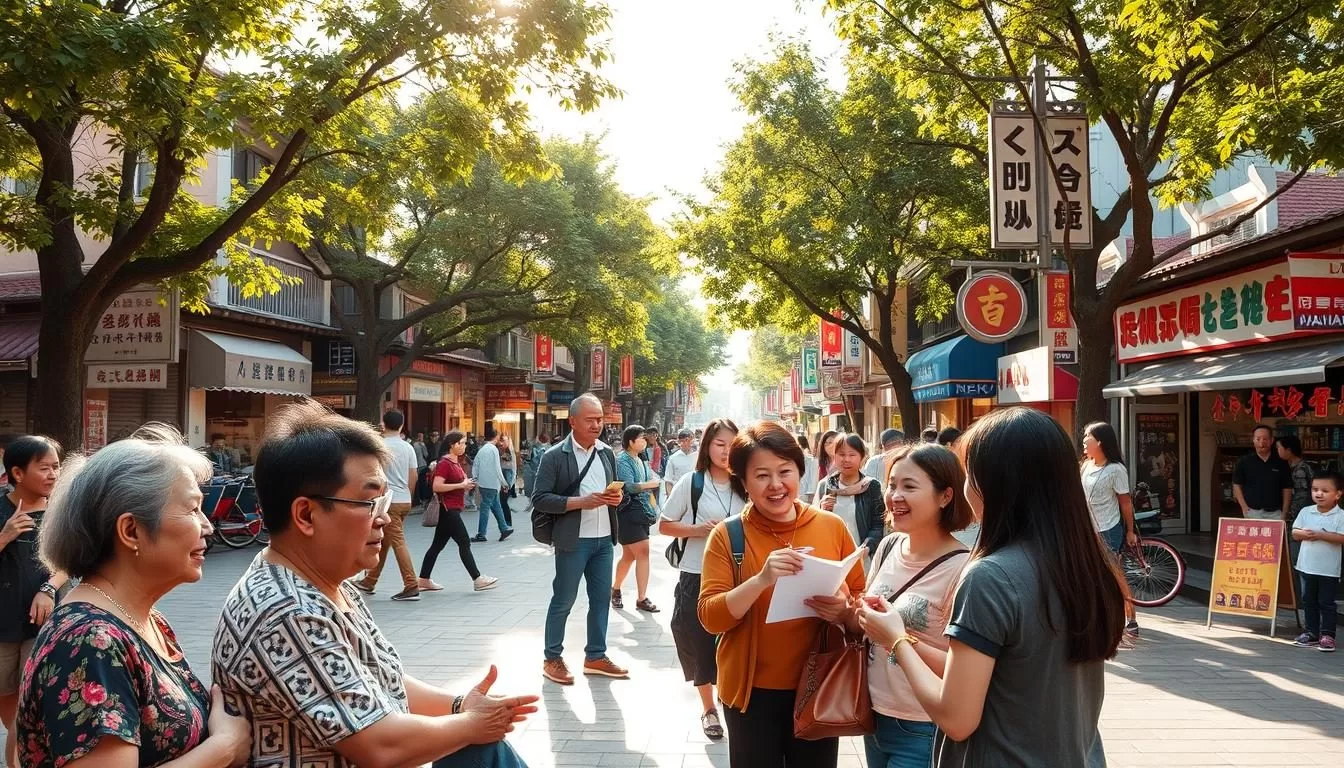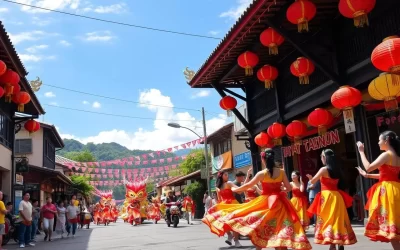✓ Accommodations✓ Flights✓ Rental Cars
As you explore Taiwan, a small island nation in East Asia with a population of over 23 million, you’ll uncover a rich tapestry of languages. While Mandarin Chinese is the official language, the island boasts a diverse linguistic landscape shaped by its complex history.
In Changhua County, located in central Taiwan, this diversity is particularly evident. The county’s language profile is a blend of various languages, reflecting Taiwan‘s history of colonization, migration, and cultural exchange. Understanding the languages spoken in this region can provide valuable insights into the local culture and community.
As you delve into the world of languages in Changhua, you’ll discover how they serve not just as means of communication but also as carriers of cultural identity and heritage.
The Linguistic Landscape of Changhua County
Exploring the diverse linguistic heritage of Changhua County reveals a complex tapestry of languages and dialects. As you delve into the region’s linguistic landscape, you will discover how language plays a vital role in shaping the identity of its people.
Geographic and Demographic Overview
Changhua County, located in western Taiwan, is characterized by its diverse ethnic and linguistic composition. The county is bordered by Taichung City to the north and Yunlin County to the south, creating a unique cultural melting pot. The demographic makeup includes Hoklo (Taiwanese) people as the majority, with significant Hakka communities and smaller numbers of mainlanders who arrived after 1949.
| Demographic Group | Language Spoken | Percentage of Population |
|---|---|---|
| Hoklo (Taiwanese) | Taiwanese Hokkien | Majority |
| Hakka | Hakka | Significant minority |
| Mainlanders | Mandarin Chinese | Smaller numbers |
Historical Influences on Language Development
The history of Changhua County has significantly influenced its language development. From aboriginal settlements to Dutch and Spanish colonization, Qing Dynasty rule, Japanese occupation, and Kuomintang governance, each period has left distinct linguistic imprints on the region. The Japanese era introduced Japanese language education, while the post-war period emphasized Mandarin Chinese.

Understanding this complex historical context is essential for appreciating how different languages coexist and interact in modern Changhua County, reflecting the culture and identity of its people.
Mandarin Chinese: The Official Language
As the official language of Taiwan since 1945, Mandarin Chinese plays a pivotal role in Changhua County. It is the primary medium of instruction in schools and is used for official documents and formal communication. You will find that nearly 80% of Taiwan’s population speaks Mandarin, making it the most widely used language across the island.
Status and Usage in Changhua County
In Changhua County, Mandarin Chinese is used in all government institutions, public education, and formal communication channels. It serves as the primary language of instruction in schools, with students learning to read and write using traditional Chinese characters. The government conducts all official business in Mandarin, including public announcements and administrative documentation. This widespread use underscores its central role in the county’s daily life.

Taiwanese Mandarin vs. Standard Mandarin
Taiwanese Mandarin, as spoken in Changhua County, has distinctive features that differentiate it from Standard Mandarin. These differences include unique pronunciation patterns, vocabulary choices, and grammatical structures influenced by local dialects. Despite these differences, Taiwanese Mandarin speakers can understand Beijing Mandarin speakers and vice versa, much like the mutual intelligibility between American and British English.
Written Form: Traditional Chinese Characters
The written form of Mandarin Chinese in Changhua County uses traditional Chinese characters, preserving cultural connections to classical Chinese literature and historical texts. This is in contrast to mainland China, where simplified Chinese characters are used. The use of traditional characters in education and government reflects Taiwan’s separate cultural development.
| Aspect | Taiwanese Mandarin | Standard Mandarin |
|---|---|---|
| Characters Used | Traditional Chinese Characters | Simplified Chinese Characters |
| Pronunciation | Influenced by local dialects | Standard pronunciation based on Beijing dialect |
| Usage in Education | Taught in schools using traditional characters | Taught using simplified characters in mainland China |
In conclusion, Mandarin Chinese is not only the official language of Taiwan but also a unifying force in Changhua County, facilitating communication across different linguistic groups. Its role in education and government further solidifies its importance in the daily lives of the county’s residents.
Taiwanese Hokkien: The Heart of Local Communication
As you explore Changhua County, you’ll discover that Taiwanese Hokkien is not just a language, but a vital part of the local identity and daily life. This language, originating from the Fujian Province in mainland China, has deep roots in the cultural fabric of Taiwan.
Prevalence and Usage Patterns in Changhua
Taiwanese Hokkien remains the heart of local communication in Changhua County, especially in rural areas, traditional markets, and among older residents. The Taiwanese language in Changhua shows subtle dialectal variations compared to other regions of Taiwan, reflecting the specific migration patterns from Fujian Province to this area.
In Changhua’s daily life, Taiwanese Hokkien often serves as the language of intimacy, used in family settings, among friends, and in traditional contexts like temples and markets. The prevalence of Hokkien varies across different parts of Changhua County, with stronger usage in fishing villages and agricultural communities compared to more urbanized areas.
Historical Development of Taiwanese Hokkien
The historical development of Hokkien in Changhua County traces back to the 17th century when migrants from Fujian Province, particularly from Quanzhou and Zhangzhou, settled in the region, bringing their language with them. Over time, Taiwanese Hokkien in Changhua developed distinctive features while maintaining mutual intelligibility with Hokkien dialects in other parts of Taiwan and southern Fujian.
Linguists suggest that the Hokkien dialect diverged from Chinese as early as the Han Dynasty (202 BC-220 AD). This historical context explains why Taiwanese Hokkien has become an integral part of the local culture and identity.
Generational Differences in Hokkien Usage
Generational differences in Hokkien usage are pronounced in Changhua County, with older generations using it as their primary language while younger people may have more limited proficiency. Despite challenges to its continued use, Taiwanese Hokkien remains a vital part of Changhua’s cultural identity and continues to be passed down through generations, though with varying degrees of fluency.
Many Changhua residents engage in code-switching between Mandarin and Hokkien depending on the social context, demonstrating the complex linguistic repertoire that characterizes local communication among the people of Changhua.
Changhua County, Taiwan: Official and widely spoken languages in Daily Life
Daily life in Changhua County is characterized by a unique blend of official and widely spoken languages. The interplay between Mandarin Chinese and Taiwanese Hokkien is particularly noteworthy, as both languages play crucial roles in different aspects of daily life.
Language in Education and Government
In Changhua County’s education system, Mandarin Chinese is the primary language of instruction. However, there has been a growing effort to incorporate Taiwanese Hokkien into the curriculum to preserve this important aspect of local cultural heritage. Similarly, local government offices conduct official business mainly in Mandarin, but many civil servants are bilingual, able to assist residents in Taiwanese Hokkien when needed.

Language in Markets and Business Settings
The traditional markets of Changhua County are vibrant linguistic environments where Taiwanese Hokkien dominates, especially among older vendors and customers. In contrast, formal business settings typically use Mandarin for official transactions, while negotiations and relationship-building often shift to Taiwanese Hokkien. This code-switching reflects the complex linguistic reality of daily life in Changhua County.
Code-Switching Practices Among Locals
Code-switching between Mandarin and Taiwanese Hokkien is a common practice among locals, who adapt their language choice based on context, audience, and subject matter. For instance, a person might use Mandarin at a bank and then switch to Taiwanese Hokkien when interacting with a local street food vendor. This flexibility in language use is a hallmark of daily communication in Changhua County.
Other Languages in Changhua’s Linguistic Mosaic
Changhua County’s linguistic landscape is characterized by a diverse array of languages, reflecting the region’s rich cultural heritage. While Mandarin Chinese and Taiwanese Hokkien are predominant, other languages also play significant roles in the county’s communication and cultural identity.
Hakka Communities and Their Language
The Hakka community in Changhua County maintains its distinct language and cultural traditions, although their numbers are smaller compared to other parts of Taiwan. The Hakka language faces preservation challenges as younger generations increasingly use Mandarin Chinese and Taiwanese Hokkien in their daily lives. Efforts to preserve the Hakka language include cultural programs and educational initiatives aimed at promoting its use among younger generations.
| Language | Speakers in Changhua | Preservation Efforts |
|---|---|---|
| Hakka | Small community | Cultural programs, education |
| Indigenous Languages | Very few speakers | Language documentation, cultural preservation |
Indigenous Languages and Preservation Efforts
Indigenous languages in Changhua County, though spoken by very few people, represent an important part of Taiwan’s aboriginal heritage. The government has implemented programs to support indigenous language education and cultural preservation, recognizing these languages as vital components of Taiwan’s diverse cultural landscape. Community-led efforts are also underway to document and preserve these linguistic treasures.

English and Japanese Influence
English has gained significant importance in Changhua’s urban centers, particularly in business, education, and tourism sectors, reflecting Taiwan’s increasing integration with the global economy. Japanese language influence remains evident in Changhua County, especially in certain vocabulary related to food, architecture, and daily life—a linguistic legacy of Taiwan’s colonial period. Language education in Changhua now includes opportunities to study multiple languages, with English being mandatory in schools and options for learning Japanese, Korean, and other languages as electives.
The way different languages coexist in Changhua demonstrates the region’s adaptability and openness to diverse cultural influences while maintaining its core linguistic identity. Business communication in Changhua increasingly requires multilingual capabilities, with companies valuing employees who can navigate between Mandarin, Taiwanese Hokkien, English, and other languages.
Conclusion
As we’ve explored, the languages spoken in Changhua County are a testament to the region’s cultural richness and historical evolution. The county’s linguistic landscape represents a microcosm of Taiwan’s rich language diversity, where Taiwanese Mandarin serves as the official language while Taiwanese Hokkien remains the heart of local cultural identity.
The languages of Changhua County reflect the island’s complex history, with each spoken language carrying traces of different historical periods and cultural influences. For businesses and visitors engaging with Changhua, understanding the nuanced way people navigate between languages provides valuable insights into local culture and effective communication strategies.
The preservation of traditional languages alongside the adoption of Taiwanese Mandarin demonstrates how the region balances cultural heritage with national unity and modernization. As Changhua County continues to develop and engage with the wider world, its linguistic landscape will likely continue evolving while maintaining the core elements that make it distinctively Taiwanese.
The above is subject to change.
Check back often to TRAVEL.COM for the latest travel tips and deals.






